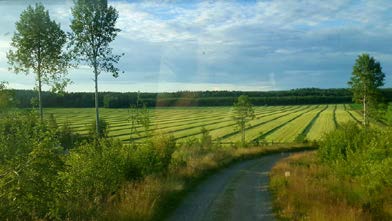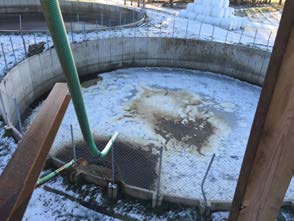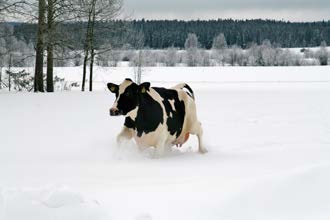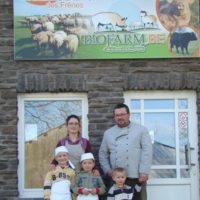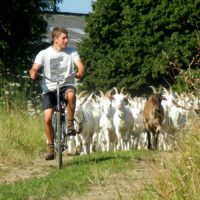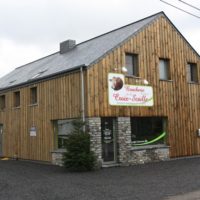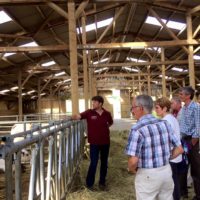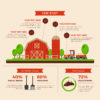Description
Background
Ersmarksängarna Farm lies near Skellefteå in Västerbotten, northern Sweden. The farm has around 185 dairy cows in an organic production system that yields 10500 kg milk per cow and year. The cows are milked three times a day. All bull calves are sold and in total the farm has just over 260 livestock units. The workforce consists of 6.5 full-time workers, within the family and with one employee. In addition, machinery contractors are hired for some of the field work.
The farm has an arable acreage of 400 ha and this area is continually being expanded as land becomes available for leasing. The soils on the farm are mainly silt-based river valley sediments that were deposited when the last ice age ended around 8500 years ago (2/3 of total area). A substantial proportion (1/3) also have a high organic matter content (>20% humus) and can be wet during spring tillage.
The climate in the region can be defined as cold continental, with mean annual precipitation of 600–700 mm. A characteristic feature is the long winter, with snow cover for around 150 days per year and an average snow depth of 60 cm. Spring tillage usually starts during May and is comple-ted during the first half of June. In winter, the temperature can fall to between -35 and -40°C, while the maximum temperature in summer can be around 30°C. Mean annual temperature is 0°C.
Another important factor for crop growth in the region is the long summer days, i.e. many hours of sunlight. During May and June, the sun does not sink below the horizon and therefore grass basically grows around the clock. Since snow melt is in April–May, when the light is already intensive, trafficability of the wetter soils is a limiting factor during spring tillage, especially on the farm’s organic soils.
Detailed description
Back in 1998, Ersmarksängarna Farm began separating its slurry and then spreading the liquid fraction via a distribution pipeline, instead of storing it all in a conventional slurry tank. There is only a short window for slurry spreading in spring and, since the farm is organic, slurry is the only fertiliser used. This is problematic for the farm’s grassland, which grows very rapidly, since it poses a risk of spores in the feed. In addition, the trafficability of the soil is limited once the ground thaws. Separating the slurry and spreading it via a pipeline has been a winning concept for the farm, which pioneered this system in northern Sweden.
Advantages
- Light equipment = Spreading can begin earlier in spring and go on for longer.
- Light equipment = Decreased soil compaction gives larger yield and higher clover content in forage.
- Lower nitrogen losses, since more slurry can be spread in the spring.
- Greater scope to spread slurry on grassland, low risk of spores in the feed.
- Lower transport and machinery costs.
Separation, storage and spreading
The system requires thin slurry, so separation of the slurry is essential. This takes place in a pumping station between the culvert and the slurry tank. The separator is run every day except on the coldest days of the year. The dry solid phase can be used as bedding if sawdust is not available. In recent years, it has mainly been used as a fertiliser and soil amendment.
The farm has a 2000 m3 slurry tank and a manure pad for the solid fraction. In addition, it uses a satellite tank that can hold 4000 m3 slurry. All slurry stored on the farm is spread via the pipeline in autumn and spring. The pipeline has a 2 km radius and distributes 100 ton slurry per hour.
Some maintenance has been required over the years, but the faults have been relatively minor. The pipeline is still intact and the farmer believes it can last another 5–10 years, although it is already 20 years old. The spreading hoses have been replaced three times and the pump has been replaced once. In the early days there were some problems with leaky connections, but these have worked well since being repaired.
Other slurry spreading
The slurry that is stored in the satellite tank is spread with a conventional slurry tanker, which is contracted in. The slurry tanker has a capacity of 25 m3 and a large proportion of the slurry is spread in the autumn. Autumn spreading is relatively common in northern Sweden, since the window for spring tillage is short. Autumn spreading results in slightly larger nitrogen losses than spring spreading. However, research carried out at the Swedish University of Agricultural Sciences (SLU) in Umeå shows that nitrogen losses in winter are lower in northern Sweden, owing to the early ground frost and the long-lasting snow cover (Lindén, 2008).
Crop rotation
Ersmarksängarna Farm grows forage crops and grain cereal. A five-year rotation is applied on the 400 ha of arable land (Table 1) and the farmer is careful to renew the grass swards frequently, in order to have large yield and high quality. The aim is to achieve good cropping and profitable production per kg total solids, and therefore the leys are never allowed to lie for more than three years.
The ley is undersown in spring barley, which is grown for grain or ensiled earlier. The spring barley variety used is either 2-row or 6-row and the usual seed rate with an undersown crop is 170 kg/ha. The seed rate for other grain cereals is usually 190 kg/ha. A mixture of spring wheat and vetch is sometimes used as the main crop and it is harvested as whole-crop silage. The grassland seed mix consists of an organic blend adapted for northern Sweden. The seed rate used for this is generally around 22 kg/ha.
Fertilisation plan
Ersmarksängarna Farm applies a cropping rotation with planned fertiliser doses. The liquid fraction of the slurry is spread over the farm, with the focus on the grass leys. The entire area around the farm, both grassland and cropland, receives liquid slurry in the spring, corresponding to around 1/3 of the total slurry volume. On the other grassland area, where the slurry is spread with a slurry tanker, the leys receive 15–20 ton/ha in autumn. The cereals in this latter area are fertilised in spring. All leys receive slurry for the regrowth in summer.
The solid fraction, which contains more phosphorus and potassium, is applied to cereal after ploughing the ley to meet the nutrient requirement and distribution as well as possible. Some fields that are in a lower potassium class according to the soil chemical classification system have greater problems with winter kill, and phosphorus and potassium play an important role in dealing with this. All cereals are also treated later with purchased fertiliser, Biofer 10-3-1, which is approved for organic cropping.
Results
It is difficult to identify any direct financial gain from the system, according to the farmer. However, it increased the possibility to convert the farm to organic. It was easier to reduce the use of mineral fertiliser once the spreading arrangements on the farm became so much better.
The previous level of soil compaction has also decreased, giving larger yields. The farmer considers this important for financial sustainability and also for long-term cropping on the soil.
Adoption criteria
Lower transport costs and distribution of phosphorus
Slurry separation is relatively common in some parts of Europe, but has still not gained a solid foothold in Sweden. It has been tested in some areas. In Halland in southern Sweden, advisors reported lower transport costs in 2011. Since a large proportion of the phosphorus content in the manure ends up in the solid fraction, it can be transported in a very cost-effective way and spread on land far from the main farm buildings (Bergström Nilsson & Blackert, 2011).
Future fertilisation strategies
The trend is for fewer, larger farms, including in northern Sweden. Since the best agricultural soils in that region are often located along river valleys, this means that the layout on larger farms is more unfavourable and the transport costs increase. Separating slurry is therefore an interesting way of reducing production costs in order to maintain competitiveness.
Future prospects
Climate change will mean a longer growing season for the northern hemisphere. Already the growing season is around 2 weeks longer for farmers in northern Sweden. The autumn has become longer and wetter and farmers must prepare for even wetter conditions. This poses a high risk of soil compaction, since the soils in the region are often weak in structure and hold a lot of water during spring and autumn tillage. When looking for ways to reduce the weight of equipment in field work, this must be considered. Spreading slurry via a distribution pipeline can be an excellent approach on farms with a suitable layout.
References
- Bergström Nilsson, B & Blackert, C. 2011. Separera gödseln för effektivare transport. Arvensis 02, 26–27.
- Lindén, B. 2008. Flytgödselspridning till hösten – möjligheterna att minska kväveutlakningsriskerna genom olika åtgärder i växtodlingen. Swedish University of Agricultural Sciences. Skara. Precisionsodling 2. ISBN 978-91-85911-75-2.

